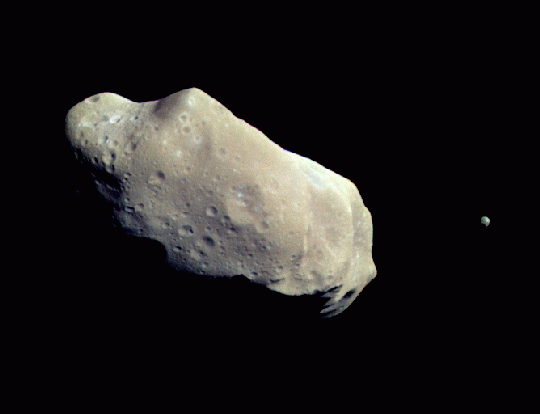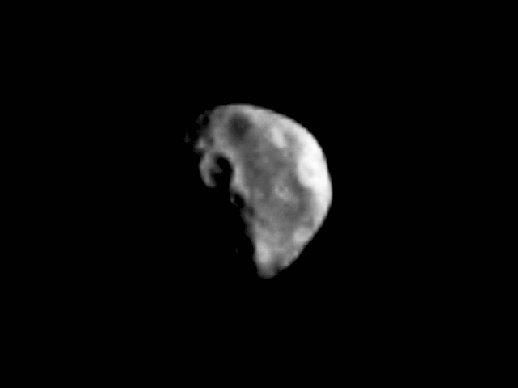

Ida/Dactyl:
Ida is a heavily cratered, irregularly shaped asteroid in the main asteroid belt. Ida is classed as a S-type. It is a member of the Koronis family, which we believe was created when a larger body perhaps 200 to 300 kilometers in diameter was smashed relatively recently.
On August 28, 1993 Galileo came within 2,400 kilometers of Ida, the second asteroid ever encountered by a spacecraft. They passed each other at a relative velocity of 12.4 km/sec (28,000 mph). At the time of the encounter, Ida and Galileo were 441 million kilometers from the Sun.
Ida is about 56 x 24 x 21 kilometers in size, more than twice as large as Gaspra. It has a period of rotation of 4 hours, 38 minutes. Its density has been estimated to be between 2.2 and 2.9 gm/cc. Ida's age is somewhat baffling. Its surface is heavily cratered suggesting that it has existed in its present form for at least a billion years and perhaps much longer. It is also considerably older than estimates for the Koronis breakup.
The greatest discovery from the Galileo fly-by was that Ida has a natural satellite. The moon has been named Dactyl by the International Astronomical Union. Dactyl is the first natural satellite of an asteroid ever discovered and photographed. The tiny moon is about 1.2 by 1.4 by 1.6 km across. The name is derived from the Dactyli, a group of mythological beings who lived on Mount Ida. The Dactyli protected the infant Zeus after the nymph Ida hid and raised the god on the mountain.

Dactyl is made more or less from the same kind of material as Ida. As an S-type asteroid, Ida is composed mostly of silicate rocks. Galileo scientists believe the moon may have been created at the same time as Ida when an older, larger asteroid was shattered in a collision with another asteroid, giving birth to dozens of smaller asteroids. Alternatively, it is possible that Ida was hit by a smaller object even more recently, leaving a crater on the asteroid and throwing off the material that became the small moon.
Galileo scientists also believe it is virtually impossible that the moon is a captured object, something created completely separately from Ida that happened to wander near the asteroid and be caught by its gravitational field. According to the laws of celestial mechanics, such an event would deflect the smaller object, but it would not be captured into orbit unless a third force of some kind slowed it down.